 Alternate Day Fasting: Benefits and How To Do This
Alternate Day Fasting: Benefits and How To Do This
Alternate day fasting is a popular approach to intermittent fasting. Those who practice this method may experience weight loss, improved insulin sensitivity, stronger immune system, and other benefits. They may enjoy the idea of fasting only every other day.
In this article, you will learn what alternate day fasting is and its potential benefits. You will also learn who should not practice alternate day fasting. If alternate day fasting is right for you, you can also learn how to practice it the right way using nutrient-dense foods and what a typical fasting schedule looks like.
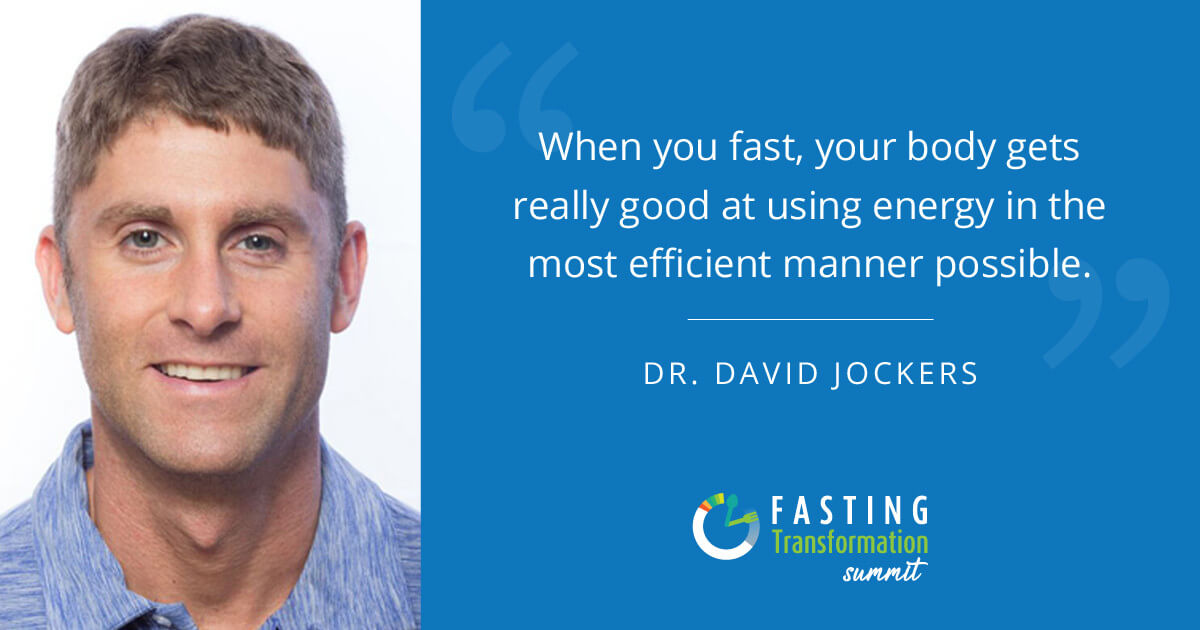
What Is Alternate Day Fasting
Alternate day fasting, a form of intermittent fasting, became a very popular form of intermittent fasting because people practicing it have seen fantastic results, including weight loss and improved insulin sensitivity. Research has also shown that alternate day fasting may particularly benefit exercise performance, may lead to reduced cravings and may help weight loss (1, 2).
Its name pretty much explains what it is. When you are practicing alternate day fasting, you are fasting every other day. One day you eat, the other day you fast.
On your fasting days, restrict your daily meals to one day a meal after about 22 to 24 hours of fasting. If you want to lose weight, restrict your calories to 500 to 1000 calories for this one meal. However, if you want to maintain your already healthy weight, make sure to eat a very large meal to meet all your calorie needs.
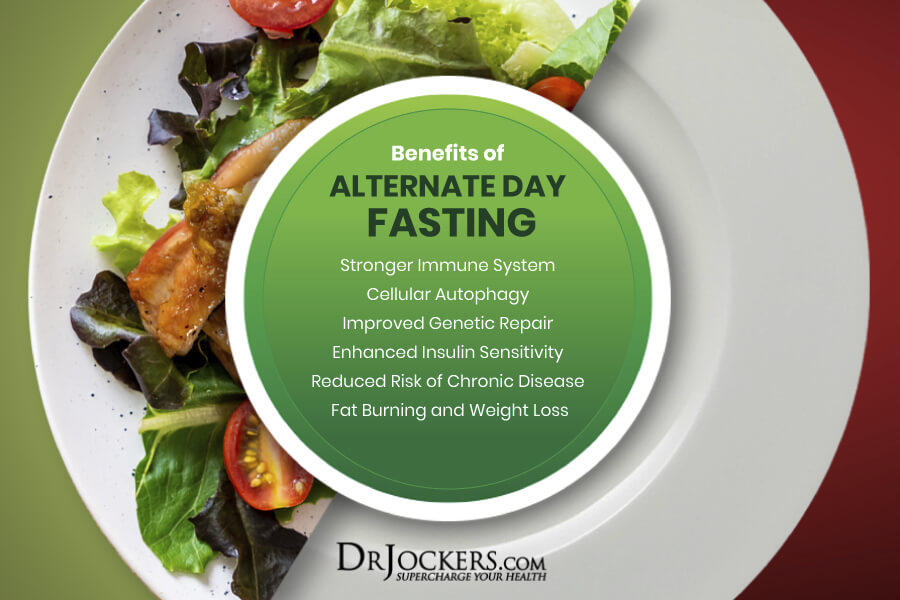
Benefits of Alternate Day Fasting
Alternate day fasting has countless health benefits, including a stronger immune system and decreased risk of chronic diseases. Let’s look at the top six benefits of alternate day fasting.
Stronger Immune System
Intermittent fasting strategies, including alternate day fasting, may be an effective way to boost your immune system. One way alternate day fasting may help your immune system is by boosting the function of neutrophils in the body.
Neutrophils are the most abundant white blood cells in the human body that play an essential role in controlling inflammatory responses and fighting infections. Having a too low or too high neutrophil count may lead to chronic and serious diseases, such as irritable bowel syndrome, chronic fatigue, heart disease, cancer, Alzheimer’s disease, rheumatoid arthritis, depression, and autoimmune diseases. Having adequate levels of neutrophils may help to neutralize pathogens and lower the risk of these conditions (3).
Alternate day fasting may also have a positive impact on your gut microbiome. Your gut plays a central role in a healthy immune system. Intermittent fasting such as alternate day fasting helps the beneficial bacteria in your gut to be more effective in destroying viruses and other pathogens (4). 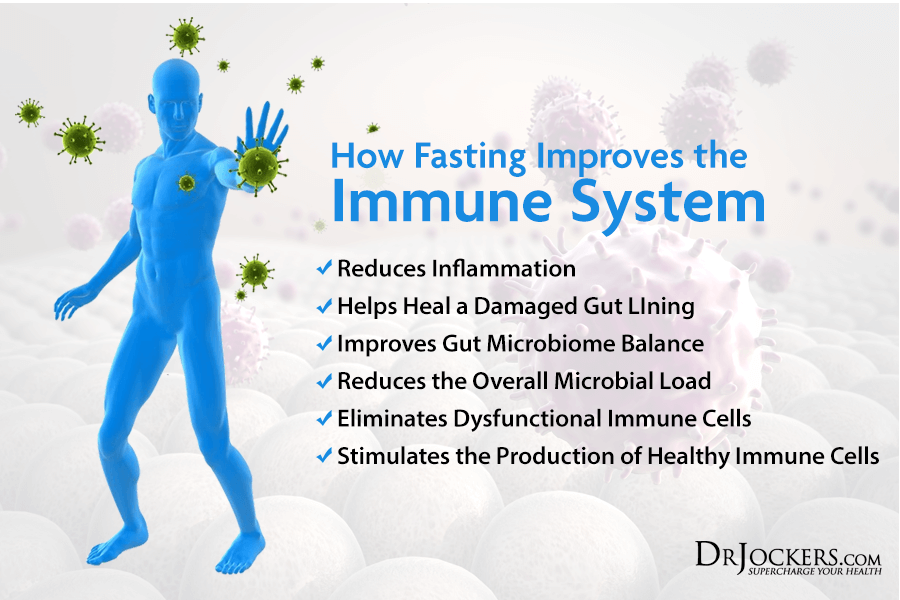
Cellular Autophagy
Cellular autophagy is a very important process in your body. It allows your body to break down old, damaged, or weakened cell components. It recycles them and creates room for new, healthy, and more efficient cells.
Autophagy is essential for controlling the replication of viruses and parasites that are one of the root causes of chronic inflammation. This is important because chronic inflammation is the underlying cause of most modern-day diseases, including heart disease, autoimmune conditions, metabolic disease, and cancer.
Stress on the body, such as time of famine, allows autophagy and cellular rejuvenation to happen. Fasting, including alternate day fasting, is a fantastic way to encourage your body to experience the state of autophagy, repair problems, and protect your body from abnormal growths, toxins, and other sources of inflammation. Since autophagy benefits are primarily gained during longer fasting cycles of 16 hours or more, alternate day fasting is a perfect way to experience these benefits by fasting for 22 to 24 hours at a time (5).
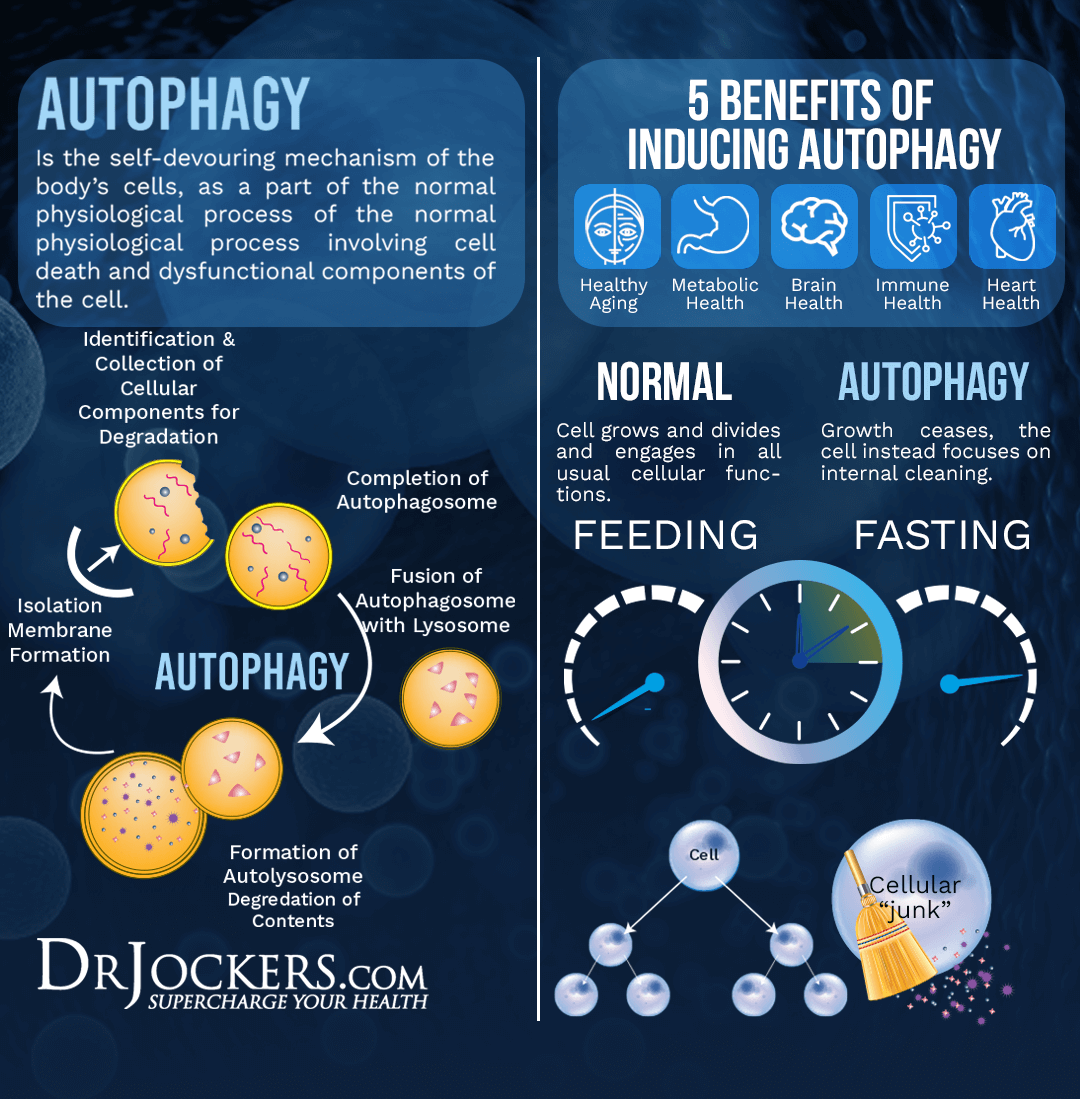
Improved Genetic Repair
Intermittent fasting strategies, such as alternate day fasting may increase lifespan by as much as 30 percent. Though this has only been shown in animal studies, not on longitudinal human studies, the results are promising, and such benefits seem plausible (6).
Other research studies have shown that intermittent fasting may boost your body’s resilience to stress, and may protect you from inflammation and neurodegenerative diseases. Protecting you from inflammation and disease most certainly can extend your lifespan and more importantly, improve the quality of our life (7, 8, 9).
The main hormone responsible for this improved repair mechanism is human growth hormone (HGH), which goes up significantly as the length of the fast increases. In fact, a study done at the Intermountain Medical Center found that men who fasted for 24 hours had a 2000% increase in HGH from baseline and women had a 1300% increase from baseline after fasting for 24 hours (10).
HGH helps improve cellular healing and stimulates fat burning, lean muscle and bone development and helps to modulate the immune system in such a way that it reduces inflammation. HGH has also been found to improve the quality of collagen tissue in our joints, skin and nails.
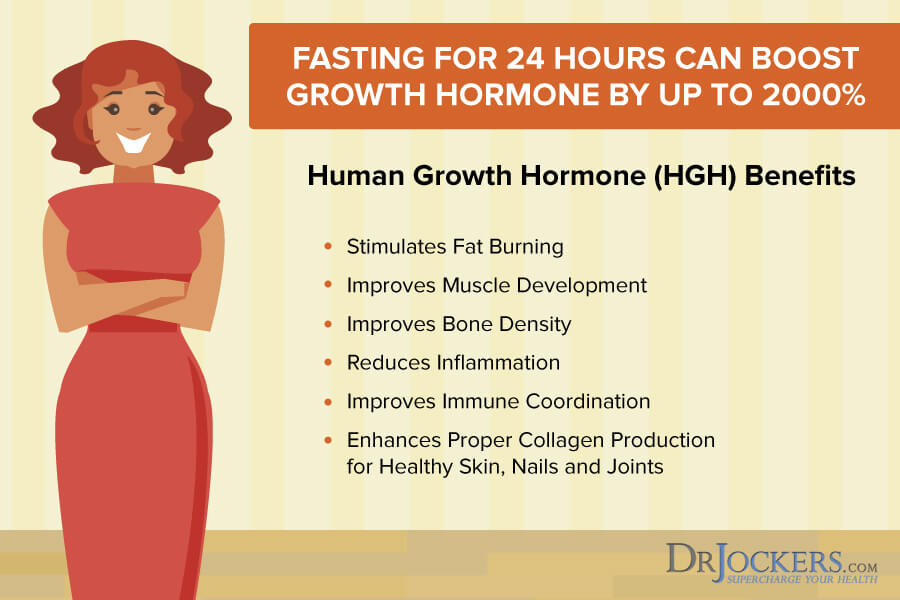
Improved Insulin Sensitivity with Alternate Day Fasting
Most people rely heavily on carbohydrates to meet their energy needs. Processed foods on the Standard American Diet are high in unhealthy carbs. Even many health-conscious individuals rely on carbs, such as whole grains, rice, pasta, and potatoes too much.
However, despite our culinary traditions and cultural habits, carbohydrates are not an ideal energy source for your body. Our bodies are actually adapted to endure and thrive during times of food scarcity where fat burning overrides carbohydrate metabolism. During this time many beneficial processes, including autophagy take place.
Eating too many carbohydrates may result in an increased risk of metabolic disorders, such as insulin resistance and diabetes. The good news is that intermittent fasting strategies, such as alternate day fasting may help to restore insulin sensitivity and stabilize your blood sugar. It can help your body to burn fat for energy instead of carbs (11).
If you want to maximize these benefits, combine alternate day fasting with a nutrient-dense real food ketogenic, or keto diet. Together they may maximize your body’s ability to regain health and vitality.

Reduced Risk of Chronic Disease
Chronic diseases are something that we all want to stay away from as far as possible. Intermittent fasting, such as alternate day fasting may lower inflammation levels, stimulate the production of more efficient mitochondria, improve immunity, and better metabolic flexibility. All these benefits may lower your risk of chronic diseases.
Research has shown that intermittent fasting, such as alternate day fasting may help to lower blood pressure, balance cholesterol levels, improve cardiovascular health, and lower the risk of cancer. It may decrease the risk of chronic inflammation, irritable bowel syndrome, inflammatory skin conditions, rheumatoid arthritis, and obesity. Moreover, it may also help with mood disorders, such as depression and anxiety, as well as neurological problems. Overall, alternate day fasting may help to optimize your overall health (12).
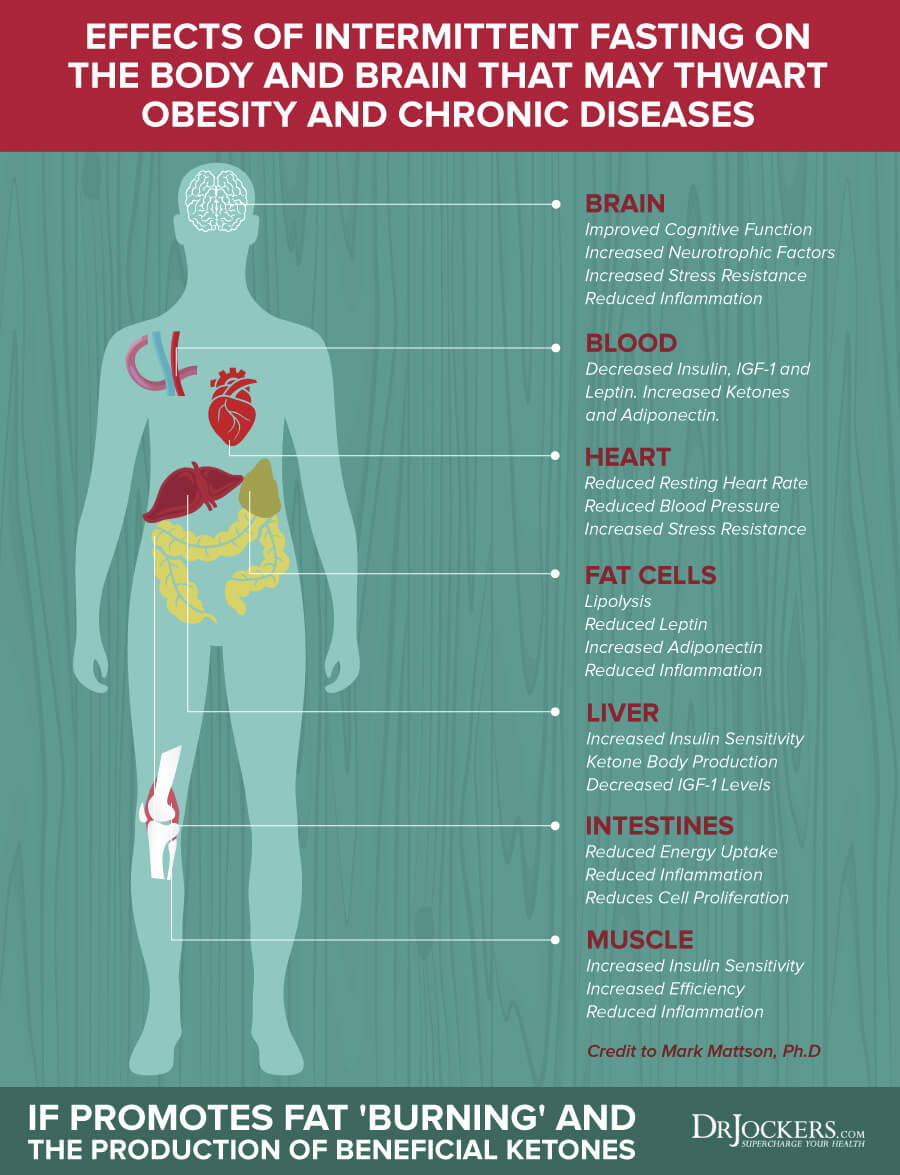
Fat Burning and Weight Loss on Alternate Day Fasting
Alternate day fasting may help with your hunger levels and your weight loss goals. Research shows that hunger levels may go down on fasting day. Alternate day fasting may create favorable changes in your hunger hormone, ghrelin and satiety hormone, leptin as well as significantly reducing insulin (13, 14, 15). This impact will result in beneficial fat burning as well as reduced hunger and cravings.
Alternate day fasting may also be easier than some other fasting methods, such as One Meal a Day (OMAD), extended fasts, or water fasting. Therefore, results may be more impactful and long-lasting.
Weight loss is not enough, however. You want to make sure that you are losing fat, not muscle or water weight. Research has shown that alternate day fasting may help to decrease both weight and fat mass while maintaining muscle mass (16, 17).
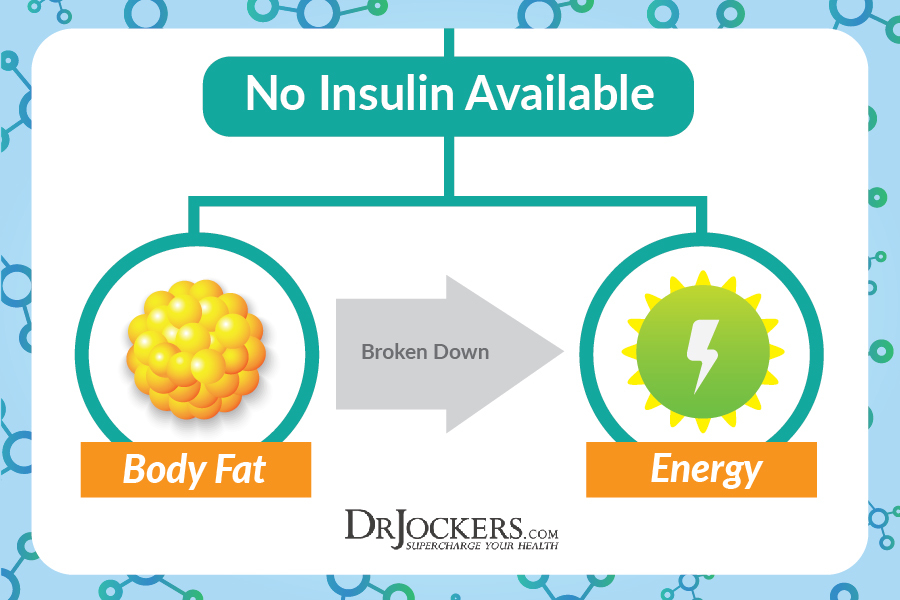
Who Shouldn’t Do Alternate Day Fasting
While alternate day fasting may be beneficial for most people, there are a few groups that should not practice it.
Pregnant Women
Pregnant women, in particular during the second and third trimesters, should not consider alternate day fasting. During this time, their babies are growing rapidly, and need a consistent nutrition supply.
Babies
Newborn babies up until six to eight months are growing rapidly. Their bodies need more calories than their stomach can handle. They need to eat regularly.
Children and Teenagers
Most children and teenagers can do a simple fast that involves up to 12 hours of fasting a day. Extended fasts, and fasting for 22 to 24 hours at a time during alternate day fasting, however, is not ideal for their developing bodies. If a child is involved in athletics or otherwise very active, even a simple fast may be challenging. You may read more about how to do a simple fast here, and determine it whether it’s right for your child or teen on a case by case basis after consulting with your healthcare provider.
Athletes Who Are in Season
Competitive athletes who are in working out a lot need a regular nutrition supply. It is important to nourish yourself before and after working out and meet your nutrient and calorie needs. Alternate day fasting and other fasting methods that require fasting for longer periods of time may compromise the performance of an athlete.
Individuals Who Are Underweight
Alternate day fasting may be a great way to lose weight or to maintain a healthy weight. However, it may not be right for individuals who are severely underweight due to a medical condition or for other reasons and need to gain weight.
Individuals with Eating Disorders
Individuals with eating disorders may run the risk of compromising their recovery process or using alternate day fasting as an eating disorder behavior tool instead of as a healthy dietary strategy. Alternate day fasting may also hinder necessary weight gain. Individuals with eating disorders should focus on recovery and developing a healthy relationship with food first.
Individuals with Type I Diabetes
Eating regularly is extremely important for those who have type I diabetes, and any fast or cleanse might throw them off balance. Individuals with type I diabetes do not produce insulin. They need insulin to be administered to maintain normal glucose levels, which may make fasting even before medical procedures more challenging.
If you are not part of any of these groups, alternate day fasting may be incredibly beneficial for you. However, it is always a good idea to speak with your healthcare professional first.

How To Do Alternate Day Fasting Right
If you practice alternate day fasting it is important that you pay attention to what you eat on your eating days and during your eating window. You need to focus on healthy whole foods that are full of micronutrients instead of food low in nutrients, such as processed foods and processed meats.
Eating a real food keto diet while practicing alternate day fasting is a fantastic way to achieve optimal results. Let’s look at some food groups and nutrient-dense foods you want to include during your eating window.
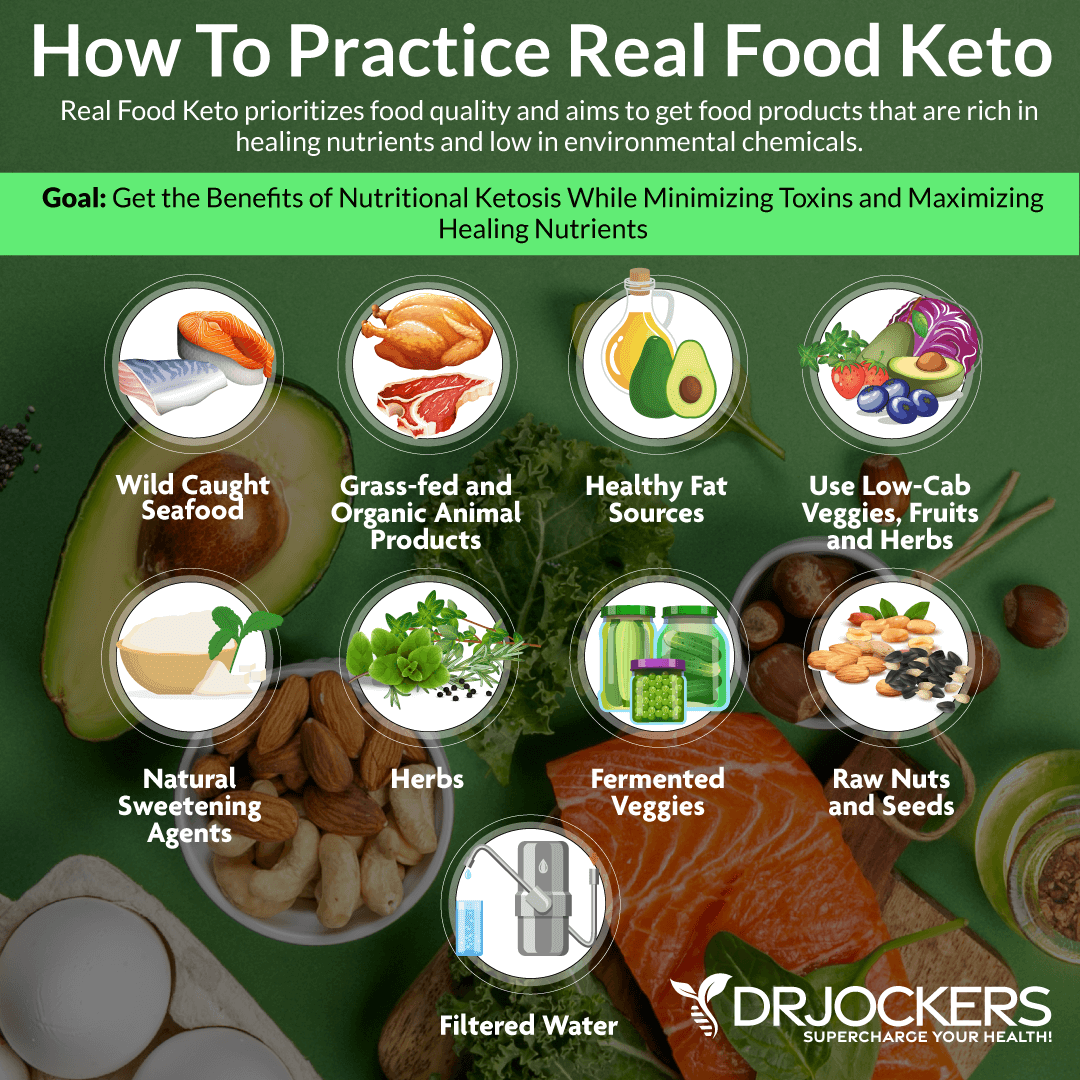
Healthy Fats
Healthy, nutrient-dense and anti-inflammatory fats are incredibly important during your eating window. Healthy fats I recommend include avocados, avocado oil, coconut oil, coconut milk, coconut butter, grass-fed butter or ghee, olives, olive oil, MCT oil, and animal fats from pastured animals, such as lard and tallow.

Antioxidants
Antioxidants are incredibly important to help your body to lower inflammation, fight free radicals, and decrease the risk of disease. There are three primary groups of antioxidants you need to eat: vegetables, low-glycemic index (low GI) fruits, and fresh herbs and spices.
Vegetables I recommend include onions, leeks, dark leafy greens, cauliflower, broccoli, asparagus, Brussels sprouts, artichokes, radishes, celery, and garlic. Low GI fruit I recommend include berries, granny smith apples, and avocados. Some herbs and spices you may want to try are basil, oregano, turmeric, cinnamon, ginger, rosemary, and cardamon.
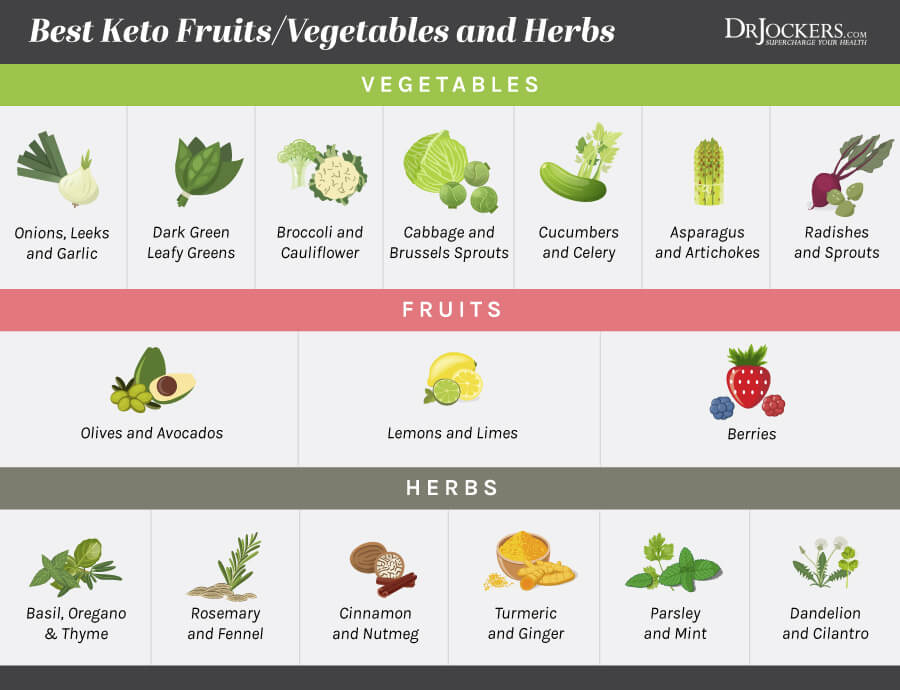
Clean Protein
Eating clean protein is important for building muscles and staying healthy. The best clean protein choices I recommend include pasture-raised beef, lamb, and bison, free-range chicken and turkey, and wild-caught fish.
Pasture-raised eggs are another nutrient-dense clean protein source you may enjoy. Can you see the best options in the image below.
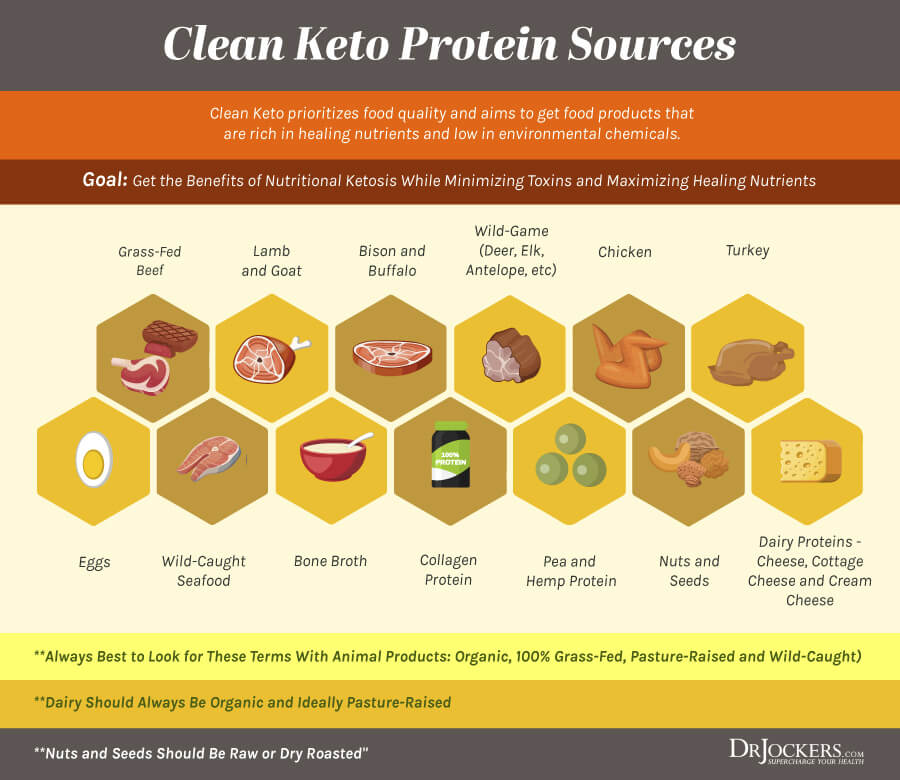
Fiber – Nuts and Seeds
Fiber is absolutely crucial for healthy digestion, gut flora balance, metabolism, immune system, and mental health. Nuts and seeds are a fantastic source of fiber. Nuts I recommend include almonds, pecans, brazil nuts, and walnuts. Seeds you may want to include are hemp seeds, chia seeds, flax seeds, and pumpkin seeds.
Fermented Foods
Fermented foods are essential when it comes to your microbiome to fuel your body with good gut bacteria. Some of the best-fermented foods include kimchi, sauerkraut, pickles, coconut milk yogurt, coconut kefir, and low-sugar probiotic beverages.

Natural Sweeteners
If you want some sweetness in your life, you may enjoy some natural sweeteners such as stevia, monk fruit, and sugar alcohols, such as xylitol and erythritol in your healthy baked goods, teas, or coffee.
If you want to learn more about how to implement a nutrient-dense diet while practicing alternate day fasting, read this article on the keto food pyramid.

Typical Alternate Day Fasting Schedule
Practicing alternate day fasting means that you are fasting one day, then eating the next day. You are alternating between fasting eating days.
For example, you may decide that your fasting days are Monday, Wednesday, and Friday. This means that on Tuesday, Thursday, and Saturday, you will be eating like normal. On Sunday, you may decide to fast as well, or you may decide to eat as you would on non-fasting days.
On fasting days, you will be fasting for 22 to 24 hours, then eating one meal. For example, you may stop eating at 6 pm on Tuesday (non-fasting day), then don’t eat until 22 to 24 hours later at 4 or 6 pm in the evening on Wednesday (fasting day). It is recommended that you still practice some level of intermittent fasting on ‘non-fasting days’.
Try not to snack or overeat at night. Give your digestion a rest instead. For example, if you stop eating at 8 pm on Wednesday (fasting day), do not eat until 8, 9, or 10 am in the morning on Thursday allowing your body 12 to 14 hours of rest and repair.
Try the following schedule during alternate day fasting:
- Monday: Fasting day. Eat one meal between 6 pm and 8 pm.
- Tuesday: Non-fasting day. Eat normally between 10 am and 6 pm.
- Wednesday: Fasting day. Eat one meal between 6 pm and 8 pm.
- Thursday: Non-fasting day. Eat normally between 10 am and 6 pm.
- Friday: Fasting day. Eat one meal between 6 pm and 8 pm.
- Saturday: Non-fasting day. Eat normally between 10 am and 6 pm.
- Sunday: Follow a fasting or non-fasting day’s protocol.
If you have a lot of weight you would like to lose, you can also do a more advanced alternate day fasting protocol such as the graphic below represents. In this fasting protocol, you go a full 40 hours between meals 3 days per week.
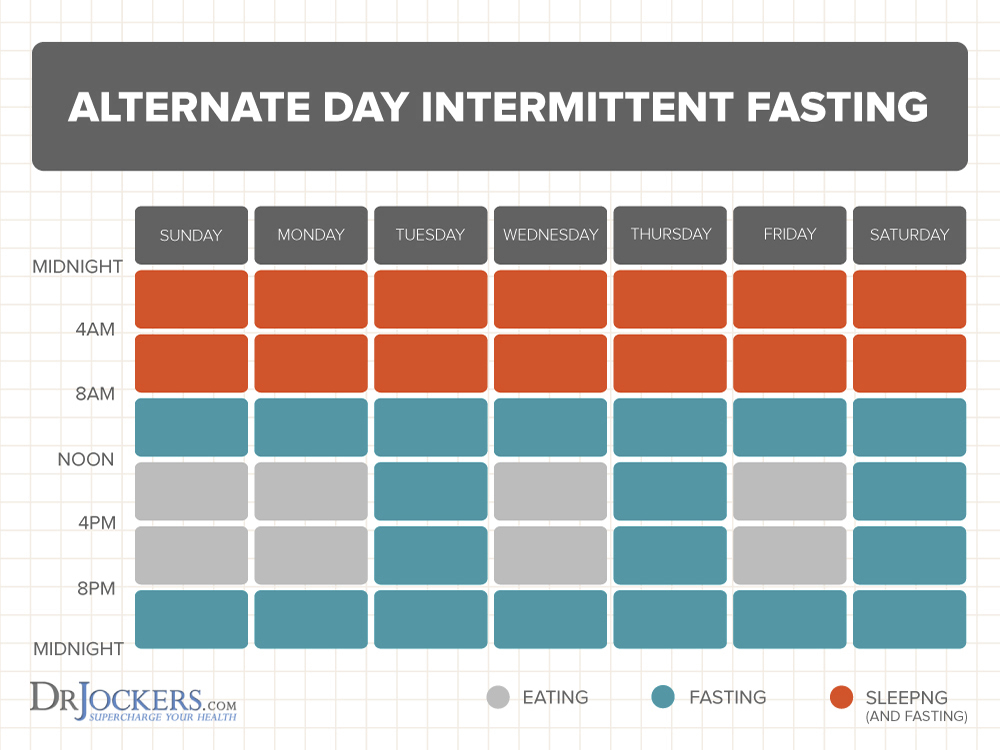
The Fasting Transformation Book
If you want to improve your metabolic health and burn fat, improve your brain and overall energy levels…intermittent and extended fasting are incredibly powerful strategies.
That is why I want to introduce you to my best-selling book, The Fasting Transformation. It goes into the most recent scientific research and strategies for implementing intermittent and extended fasting into your life.
This book is the best book on fasting the world has ever seen and I have read them all! It is now, my great honor to present this to you and I am deeply appreciative of your support!
Metabolic Autophagy & Cellular Healing Masterclass
Autophagy is the body’s innate mechanism for deep cellular healing and repair and it helps us reduce the effects of aging, inflammation and cellular damage.
The Nobel Prize in 2016 was awarded to the Japanese researcher Yoshinori Ohsumi for his breakthrough work in helping us understand the process of autophagy and how it works. If you are struggling with your health or desire to optimize your health, activating the appropriate amount of autophagy is a critical component.
This masterclass will give you in-depth video trainings along with image-rich, research-based guides to help you understand the tools and strategies to unlock your body’s dormant healing potential. You will also learn my signature 6-week Metabolic Reset Cycle that will show you how to utilize advanced nutrition strategies for deep cellular healing!
Check out the masterclass here where you will learn my best action steps for optimal healing!
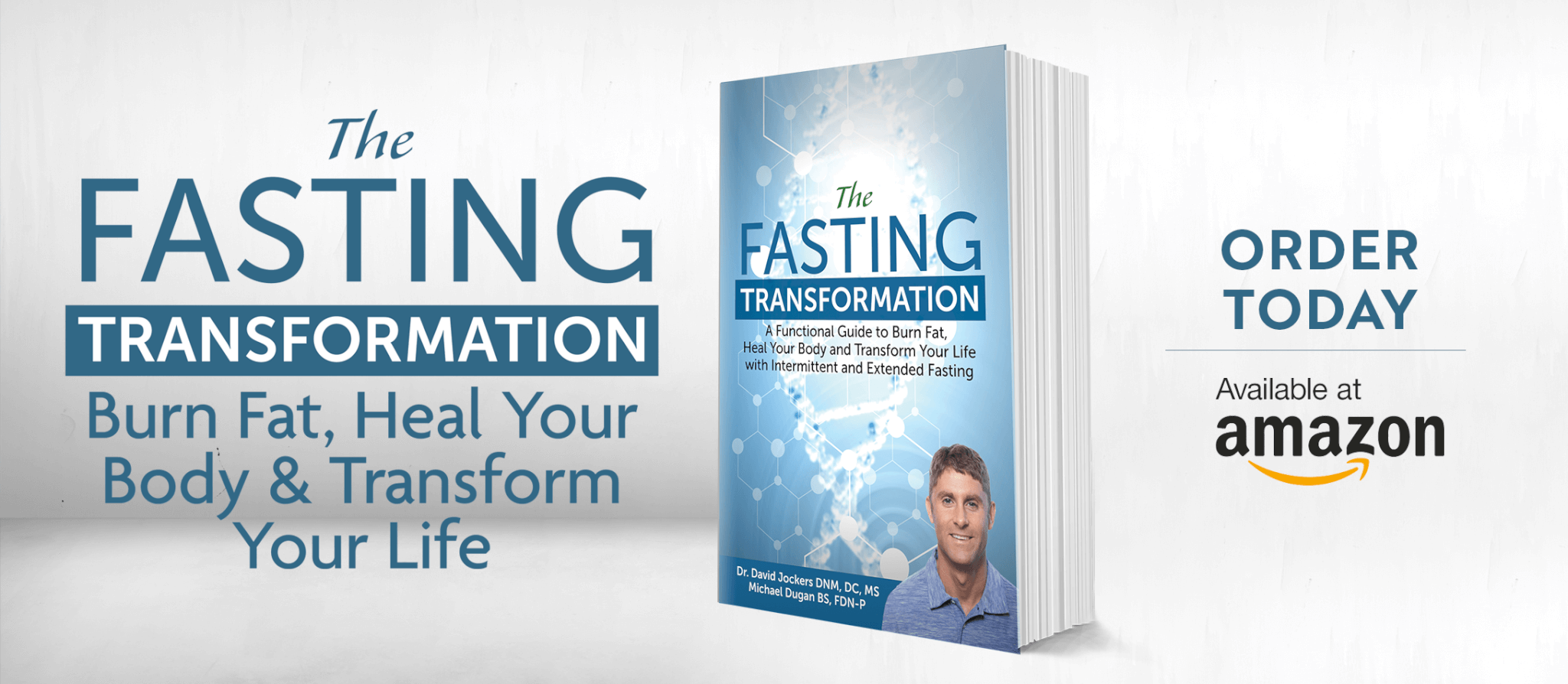
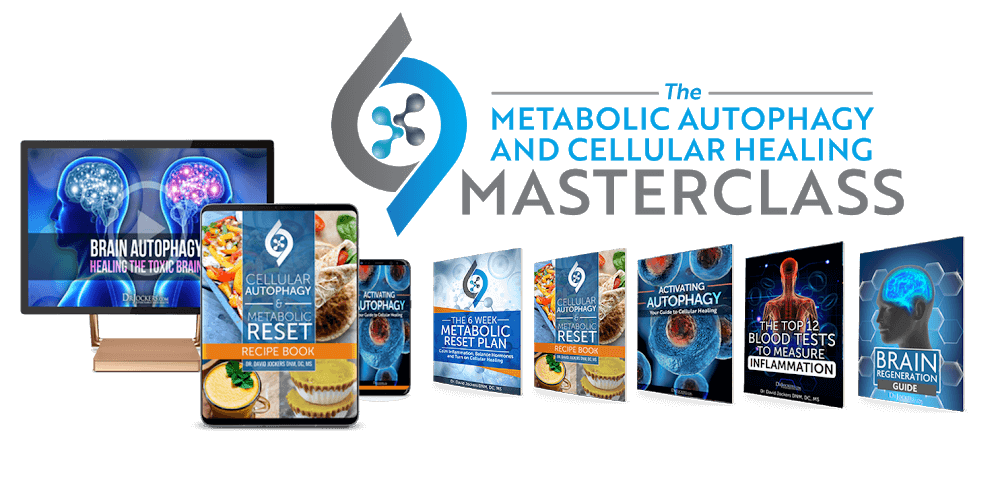



I currently live in a senior building, where meals are prepared for you. So should i eat mon, wed, fri, and fast sat,and sun?
Hey Stanley, yes I would recommend fasting on Monday, Wednesday and Friday and doing 2-3 meals on Tues, Thurs, Sat and Sunday. Blessings!
I am very interested in this approach to not only weight loss but health in general however being vegetarian I don’t eat meat or fish. Most of the time I tend to lean more towards a vegan diet as I am not keen on too many eggs. My diet is high in things like lentils, chickpeas, legumes etc, for protein and it is as a result, a high carb diet. I find it hard to track nutrients as a lot of meals are things like Vegetarian chilli, chickpea curry etc. unlike a piece of protein and veg/salad which is easy to track. Your advice will be most appreciated. Thank you, Lynette
Yes you can certainly do this on a vegetarian plan.
I have been doing alternate day fasting for months now and getting great results. However, I am a little concerned because I came across a report/study shared by Dr. Gregor that showed Alternate day fasting can raise your cholesterol. I know during keto your cholesterol can raise and then will eventually balance out. I am wondering if this is the same kind of effect. Do you know anything about this study? What are your thoughts on this issue?
Hey Bernie, no worries about this as Fasting helps to improve your lipid balance and lower triglycerides. In fact, IF is one of the very best things you can do for cardiovascular health.